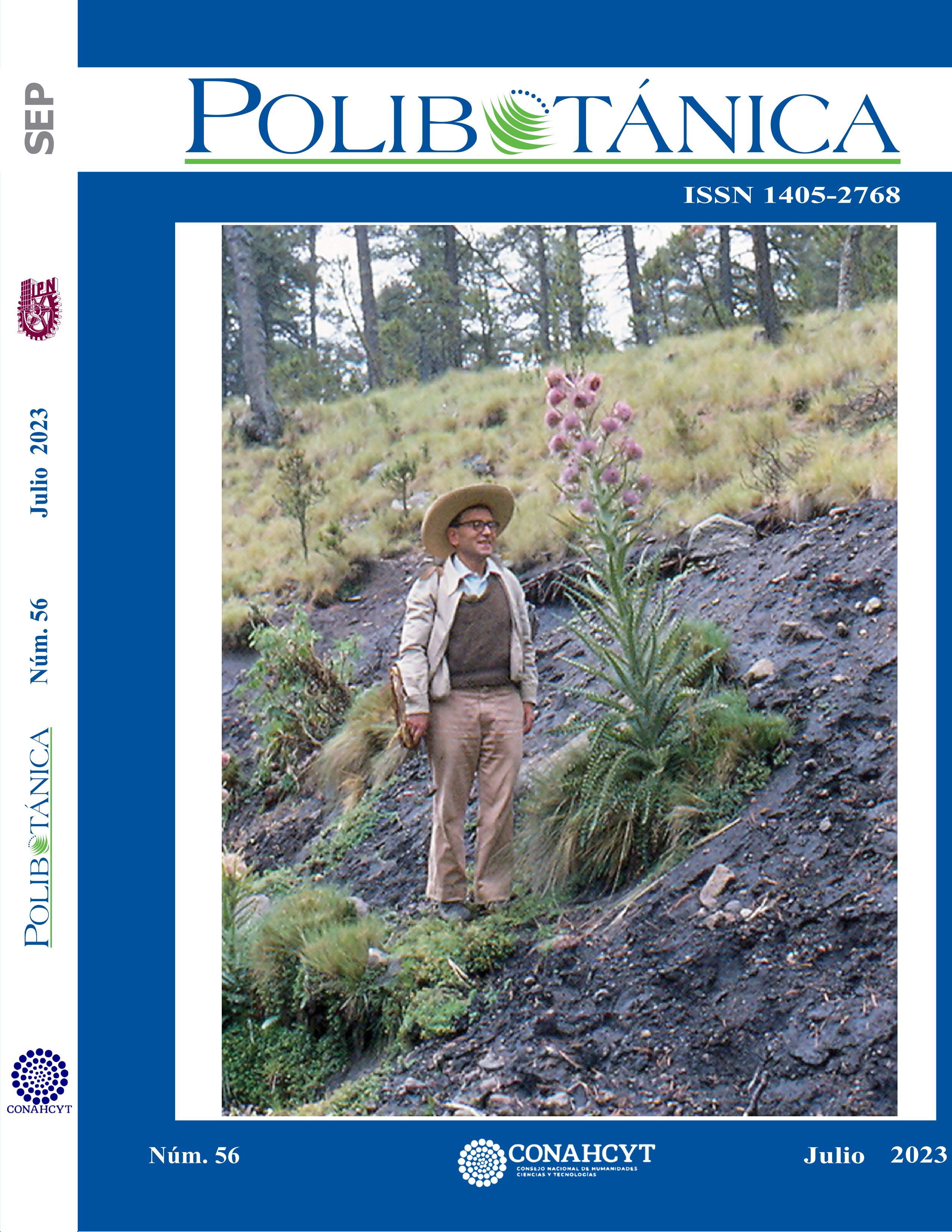Studies of medicinal plants used in San Jose Iturbide, Guanajuato, Mexico
DOI:
https://doi.org/10.18387/polibotanica.56.14Keywords:
Asteraceae, Matricaria chamomilla L., medicinal plants, infusionAbstract
A study of medicinal plants was carried out to collect information on their use in the region of San José Iturbide, Guanajuato, México. The area has a large number of endemic medicinal species, which are of great importance in the region for the treatment of different diseases. In this study, the plants currently used were identified, traditional knowledge was recorded and the diseases treated in the community were documented. A total of 50 medicinal plants, belonging to 27 botanical families, were described with the help of 63 local informants. The Laminaceae family was the one with the largest number of species described by the informants (nine species), however, the most cited species belonged to the Asteraceae family (Matricaria chamomilla L.) with 17 reports of use. In general, all parts of the plants are used to treat diseases, however, the leaves are used mostly (57.14%). According to informants, infusion is the most used way of using medicinal plants with 69.31%. The medicinal plants are used to treat diseases of the digestive system, chronic degenerative diseases, diseases of the urinary system, diseases of the respiratory system, diseases of the cardiovascular system, diseases of the reproductive system and diseases of the nervous system. This study tells us that, in San Jose Iturbide, Guanajuato, Mexico, some families still depend on the use of medicinal plants, which is important to continue preserving traditional cultures.
References
Aniya, Nomura, Y., Fuerdeng, Appiah, K. S., & Fujii, Y. (2020). Evaluation of allelopathic activity of Chinese medicinal plants and identification of shikimic acid as an allelochemical from Illicium verum Hook. f. Plants, 9(6), 684. doi: 10.3390/plants9060684
Ayyanar, M., & Ignacimuthu, S. (2011). Ethnobotanical survey of medicinal plants commonly used by Kani tribals in Tirunelveli hills of Western Ghats, India. Journal of Ethnopharmacology, 134(3), 851–864. doi: 10.1016/j.jep.2011.01.029
Boukhatem, M. N., & Setzer, W. N. (2020). Aromatic herbs, medicinal plant-derived essential oils, and phytochemical extracts as potential therapies for coronaviruses: Future perspectives. Plants, 9(6), 800. doi: 10.3390/plants9060800
Buso, P., Manfredini, S., Ahmadi-Ashtiani, H. R., Sciabica, S., Buzzi, R., Vertuani, S., & Baldisserotto, A. (2020). Iranian medicinal plants: From ethnomedicine to actual studies. Medicina, 56(3), 97. doi: 10.3390/medicina56030097
Case, R. J., Pauli, G. F., & Soejarto, D. D. (2005). Factors in maintaining indigenous knowledge among ethnic communities of Manus Island. Economic Botany, 59(4), 356–365. doi: 10.1663/0013-0001(2005)059[0356:FIMIKA]2.0.CO;2
Ceuterick, M., Vandebroek, I., Torry, B., & Pieroni, A. (2008). Cross-cultural adaptation in urban ethnobotany: The Colombian folk pharmacopoeia in London. Journal of Ethnopharmacology, 120(3), 342–359. doi: 10.1016/j.jep.2008.09.004
Chávez Mejía, M. C., White Olascoaga, L., Moctezuma Pérez, S., & Herrera Tapia, F. (2017). Prácticas curativas y plantas medicinales: un acercamiento a la etnomedicina de San Nicolás, México. Cuadernos Geográficos, 56(2), 26–47.
Cortés-Chitala, M. D. C., Flores-Martínez, H., Orozco-Ávila, I., León-Campos, C., Suárez-Jacobo, Á., Estarrón-Espinosa, M., & López-Muraira, I. (2021). Identification and quantification of phenolic compounds from mexican oregano (Lippia graveolens HBK) hydroethanolic extracts and evaluation of its antioxidant capacity. Molecules, 26(3), 702. doi: 10.3390/molecules26030702
Faruque, M. O., Uddin, S. B., Barlow, J. W., Hu, S., Dong, S., Cai, Q., Li, X., & Hu, X. (2018). Quantitative ethnobotany of medicinal plants used by indigenous communities in the Bandarban district of Bangladesh. Frontiers in Pharmacology, 9, 40. doi: 10.3389/fphar.2018.00040
Ferreira, F. S., Brito, S. V., Ribeiro, S. C., Saraiva, A. A. F., Almeida, W. O., & Alves, R. R. N. (2009). Animal-based folk remedies sold in public markets in Crato and Juazeiro do Norte, Ceará, Brazil. BMC Complementary and Alternative Medicine, 9(17), 1–8. doi: 10.1186/1472-6882-9-17
Gao, L., Wei, N., Yang, G., Zhang, Z., Liu, G., & Cai, C. (2019). Ethnomedicine study on traditional medicinal plants in the Wuliang Mountains of Jingdong, Yunnan, China. Journal of Ethnobiology and Ethnomedicine, 15(41), 1–20. doi: 10.1186/s13002-019-0316-1
Gutiérrez, J., & Solano, E. (2014). Afinidades florísticas y fitogeográficas de la vegetación del municipio de San José Iturbide, Guanajuato, México. Acta Botanica Mexicana, 107, 27–65. doi: 10.21829/abm107.2014.203
Guzmán-Maldonado, S. H., Díaz-Huacuz, R. S., & González-Chavira, M. M. (2018). Plantas medicinales la realidad de una tradición ancestral. Instituto Nacional de Investigaciones Forestales, Agrícolas y Pecuarias (INIFAP). México.
Hernández-Sandoval, L. G., Pantoja-Hernández, Y., & Martínez, M. (2012). Plantas útiles y distribución potencial de las forrajeras, medicinales y de uso múltiple. En: La Biodiversidad en Guanajuato: Estudio de Estado vol. I. México. Comisión Nacional para el conocimiento y Uso de la Biodiversidad (CONABIO)/Instituto de Ecología del Estado de Guanajuato (IEE), pp. 274-289.
Jiménez González, A., Mora Zamora, K. J., Rosete Blandariz, S., & Cabrera Verdesoto, C. A. (2021). Utilización de plantas medicinales en cuatro localidades de la zona sur de Manabí, Ecuador. Siembra, 8(2), e3223. doi: 10.29166/siembra.v8i2.3223
Kasole, R., Martin, H. D., & Kimiywe, J. (2019). Traditional medicine and its role in the management of diabetes mellitus: “patients’’ and herbalists’ perspectives".” Evidence-Based Complementary and Alternative Medicine, 2019, 1–12. doi: 10.1155/2019/2835691
Lara Reimers, E. A., Fernández Cusimamani, E., Lara Rodríguez, E. A., Zepeda del Valle, J. M., Polesny, Z., & Pawera, L. (2018). An ethnobotanical study of medicinal plants used in Zacatecas state, Mexico. Acta Societatis Botanicorum Poloniae, 87(2), 3581. doi: 10.5586/asbp.3581
Marković, M., Pljevljakušić, D., Kojičić, K., & Cupara, S. (2020). Ethnopharmacological application of chamomile (Matricaria chamomilla L.) in the pirot county of Southeastern Serbia. Arhiv Za Farmaciju, 70(4), 238–247. doi: 10.5937/arhfarm2004238M
Martínez-Cruz, J., & Téllez-Valdés, O. (2004). Listado florístico de la Sierra de Santa Rosa, Guanajuato, México. Botanical Sciences, 74, 31–49. doi: 10.17129/botsci.1685
Nugraha, R. V., Ridwansyah, H., Ghozali, M., Khairani, A. F., & Atik, N. (2020). Traditional Herbal Medicine Candidates as Complementary Treatments for COVID-19: A Review of Their Mechanisms, Pros and Cons. Evidence-Based Complementary and Alternative Medicine, 2020, 1–12. doi: 10.1155/2020/2560645
Nunkoo, D. H., & Mahomoodally, M. F. (2012). Ethnopharmacological survey of native remedies commonly used against infectious diseases in the tropical island of Mauritius. Journal of Ethnopharmacology, 143(2), 548–564. doi: 10.1016/j.jep.2012.07.013
Odieka, A. E., Obuzor, G. U., Oyedeji, O. O., Gondwe, M., Hosu, Y. S., & Oyedeji, A. O. (2022). The Medicinal Natural Products of Cannabis sativa Linn.: A Review. Molecules, 27(5), 1689. doi: 10.3390/molecules27051689
OMS. (2020). Tendencias de la mortalidad y los factores de riesgo de las enfermedades no transmisibles, y muertes por lesiones y violencia: In Estadísticas Sanitarias Mundiales 2020.
Pamunuwa, G., Karunaratne, D. N., & Waisundara, V. Y. (2016). Antidiabetic Properties, Bioactive Constituents, and Other Therapeutic Effects of Scoparia dulcis. Evidence-Based Complementary and Alternative Medicine, 2016, 1–11. doi: 10.1155/2016/8243215
Picking, D., Younger, N., Mitchell, S., & Delgoda, R. (2011). The prevalence of herbal medicine home use and concomitant use with pharmaceutical medicines in Jamaica. Journal of Ethnopharmacology, 137(1), 305–311. doi: 10.1016/j.jep.2011.05.025
Rivero-Segura, N. A., & Gomez-Verjan, J. C. (2021). In silico screening of natural products isolated from mexican herbal medicines against covid-19. Biomolecules, 11(2), 216. doi: 10.3390/biom11020216
Secretaría de Bienestar. (2022). Informe anual sobre la situación de pobreza y rezago social 2022. Unidad de planeación y evaluación de programas para el desarrollo. Guanajuato, San José Iturbide. https://www.gob.mx/cms/uploads/attachment/file/699159/11_032_GTO_San_Jose__Iturbide.pdf. Fecha de consulta 25 de noviembre de 2022.
SEMARNAT. (2021). Plantas medicinales de México. Gobierno de México. https://www.gob.mx/semarnat/articulos/plantas-medicinales-de-mexico?idiom=es. Fecha de consulta 25 de octubre de 2022.
Siew, Y. Y., Zareisedehizadeh, S., Seetoh, W. G., Neo, S. Y., Tan, C. H., & Koh, H. L. (2014). Ethnobotanical survey of usage of fresh medicinal plants in Singapore. Journal of Ethnopharmacology, 155(3), 1450–1466. doi: 10.1016/j.jep.2014.07.024
Spindle, T. R., Bonn-Miller, M. O., & Vandrey, R. (2019). Changing landscape of Cannabis: novel products, formulations, and methods of administration. Current Opinion in Psychology, 30, 98–102. doi: 10.1016/j.copsyc.2019.04.002
Vara-Delgado, A., Sosa-González, R., Alayón-Recio, C. S., Ayala-Sotolongo, N., Moreno-Capote, G., & Alayón-Recio, V. del C. (2019). Uso de la manzanilla en el tratamiento de las enfermedades periodontales. Revista Archivo Médico de Camagüey, 23(3), 403–414.
Vásquez-Montes, S., Villarrwal-Guerrero, F., Amaya-Olivas, N. I., & Hernández-Ochoa, L. R. (2020). Production and chemical composition of Dalea bicolor essential oil in different regions of Chihuahua State, Mexico. Botanical Sciences, 98(4), 486–498. doi: 10.17129/botsci.2602
Villagómez, M. A., Maldonado M. & Esparza, J. J. (2012). Actualización del programa de manejo del área natural protegida Pinal del Zamorano. CIATEC/IEE. México. pp: 121-127
Villagómez-Loza, M. A., Bello-González, M. A., & Isarain-Chávez, E. (2014). Pinus strobiformis Engelmann: A new location in Guanajuato, Mexico. Agrociencia, 48(6), 615–625.
Villaseñor, J. L. (2016). Checklist of the native vascular plants of Mexico. Revista Mexicana de Biodiversidad, 87(3), 559–902. doi: 10.1016/j.rmb.2016.06.017
Weaver, R. J., Blomme, E. A., Chadwick, A. E., Copple, I. M., Gerets, H. H. J., Goldring, C. E., Guillouzo, A., Hewitt, P. G., Ingelman-Sundberg, M., Jensen, K. G., Juhila, S., Klingmüller, U., Labbe, G., Liguori, M. J., Lovatt, C. A., Morgan, P., Naisbitt, D. J., Pieters, R. H. H., Snoeys, J., … Park, B. K. (2020). Managing the challenge of drug-induced liver injury: a roadmap for the development and deployment of preclinical predictive models. Nature Reviews Drug Discovery, 19(2), 131–148. doi: 10.1038/s41573-019-0048-x
Weckmüller, H., Barriocanal, C., Maneja, R., & Boada, M. (2019). Factors affecting traditional medicinal plant knowledge of the Waorani, Ecuador. Sustainability, 11(16), 4460. doi: 10.3390/su11164460
Zambrano-Intriago, L. F., Buenaño-Allauca, M. P., Mancera-Rodríguez, N. J., & Jiménez-Romero, E. (2015). Estudio etnobotánico de plantas medicinales utilizadas por los habitantes del área rural de la Parroquia San Carlos, Quevedo, Ecuador. Universidad y Salud, 17(1), 97–111.
Žlabur, J. Š., Žutić, I., Radman, S., Pleša, M., Brnčić, M., Barba, F. J., Rocchetti, G., Lucini, L., Lorenzo, J. M., Domínguez, R., Brnčić, S. R., Galić, A., & Voća, S. (2020). Effect of Different Green Extraction Methods and Solvents on Bioactive Components of Chamomile (Matricaria chamomilla L.) Flowers. Molecules, 25(4), 810. doi: 10.3390/molecules25040810
Downloads
Published
Issue
Section
License

Polibotánica by Departamento de Botánica de la Escuela Nacional de Ciencias Biológicas del Instituto Politécnico Nacional se distribuye bajo una Licencia Creative Commons Atribución-NoComercial-CompartirIgual 4.0 Internacional.




















